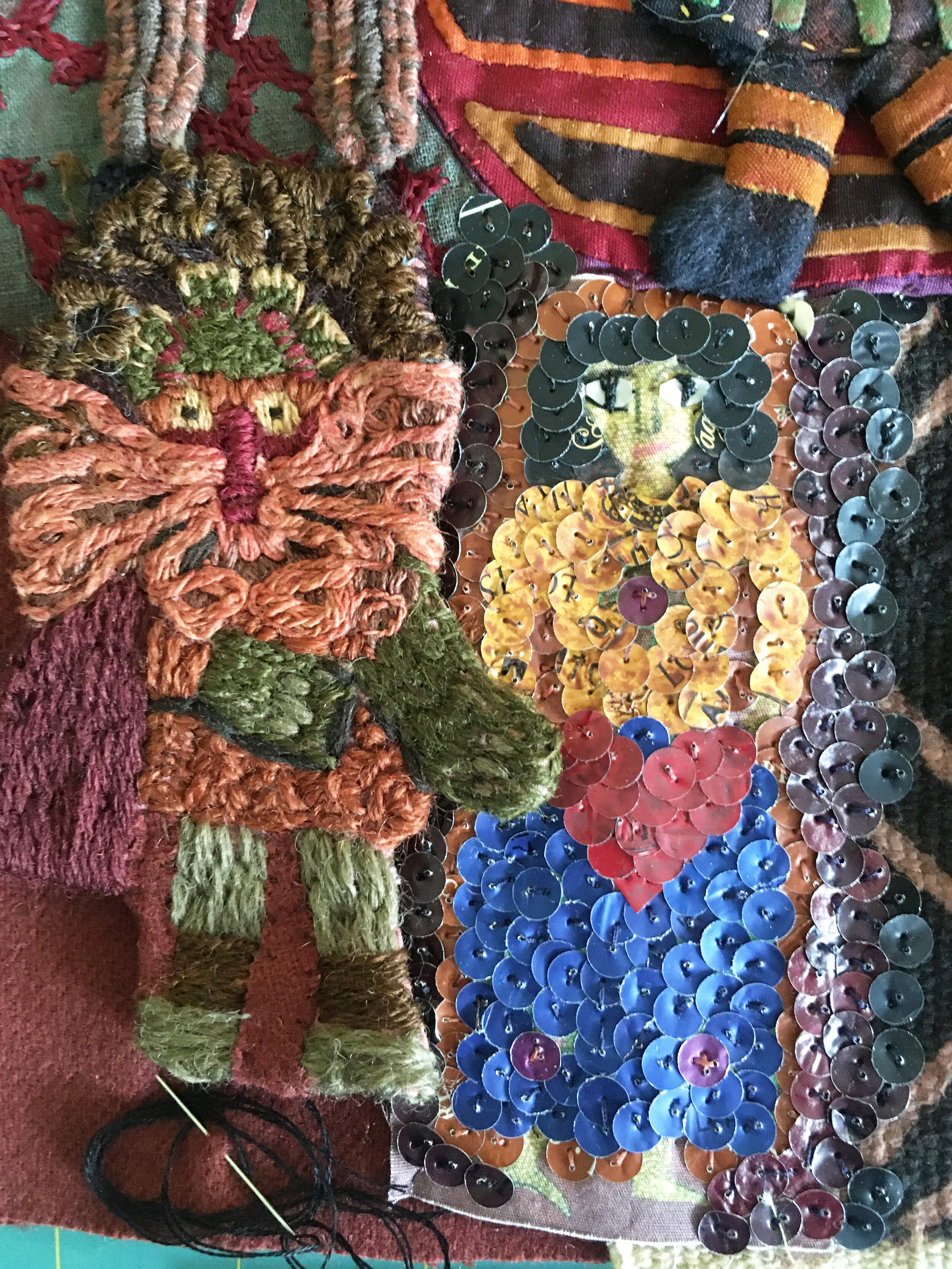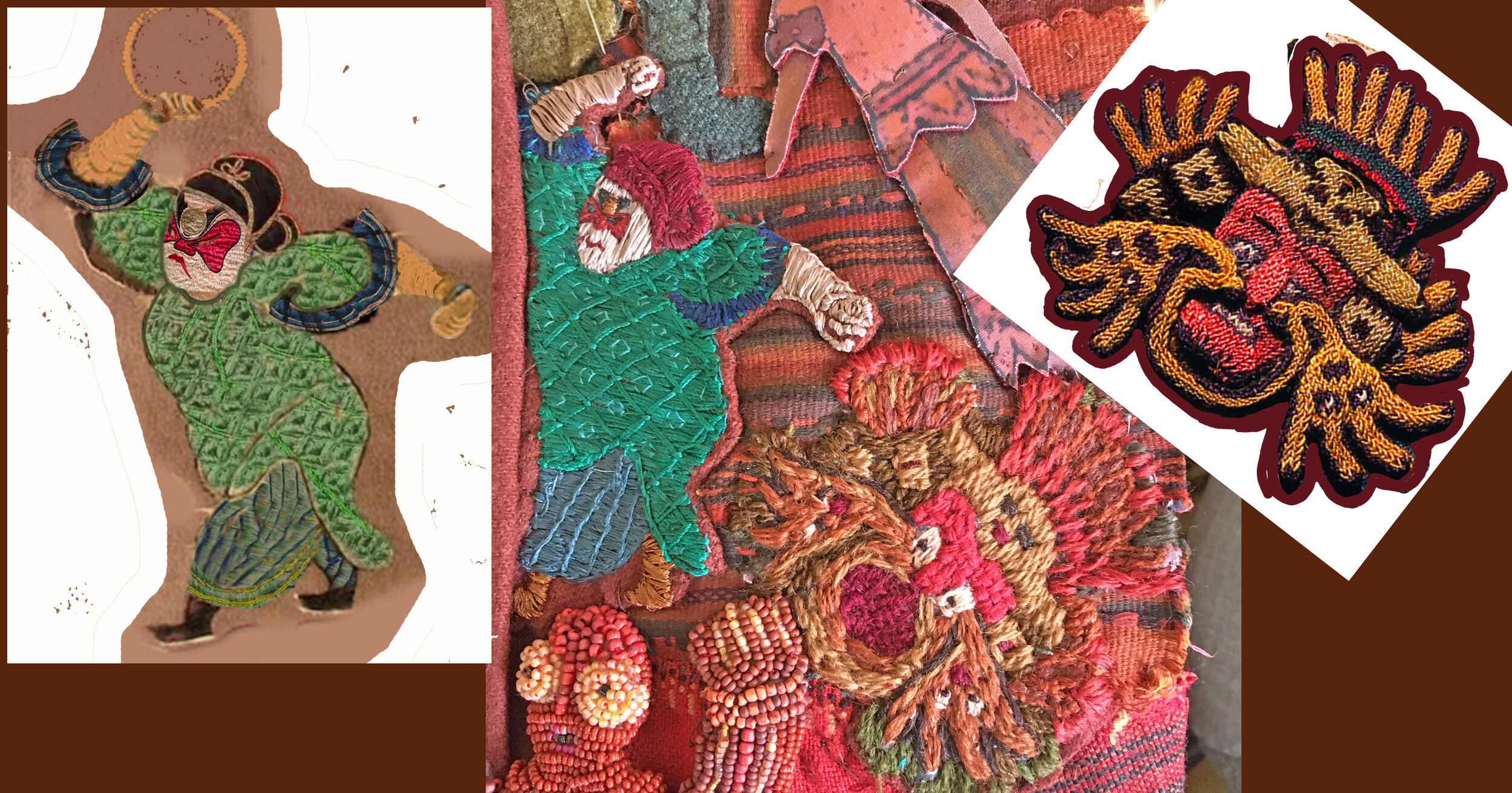I do need a name for this piece. ‘Opus Anglicanum” translates to English work. Since Mundi is Latin for world, would “Opus Mundi” translate to work of the world? Suggestions welcome. I am so glad this is finished. Now what?
How we really stitch ourselves...
Lots of work going on here. I’m researching more and more figures - googling story cloths and narrative textiles and figural stitching and then looking at many screens of images until one says ‘yes, me’, and then going down that road until I either find amazing figures or the path dies out. I keep making new (better?) figures and retiring others.
FIRST: HAITIAN DRAPO SERVIS
(Above) Haitian sequined flags are not hung on flagpoles. They are entirely covered in sequins and beads. They originated as drapo servis, which are important religious icons. Kept in shrine rooms, they are carried by flag bearers in elaborate ceremonies . A drapo servis will include an image of a Catholic saint or an emblem of a spirit.
Art flags show much wider variation in size and theme than drapo servis. Some flags are closer to tapestries. In the 1950s collectors started to buy drapo Vodou, and the priests began to make them for sale as a source of income.
. My small figure is based on images found by Googling Haitian flags sequins. I simplified the figure, printed it out on cloth and instead of shiny sequins, I punched circles out of the foil covers from wine bottles (tiny, non-shiny sequins!) and sewed those on.
NEXT: MORE HAITIAN SEQUINS AND A PARACAS FIGURE
(Above, the originals) Among the frame figures, I’m including several figures copied from the edge of the Paracas Textile. I wish I could have gotten to the Brooklyn Museum to see the actual textile in the cloth, but it’s a pandemic no-go. How big are these figures? I’m estimating them each at around 5” tall, which is only slightly larger than mine, yet look at the detail of those stitches! Truly - artistry at least on a par with the Opus Angelicanum. And another sequined figure, again, much more detailed than mine (Below, my versions)
NEXT: CANDELARIA WOVEN FIGURE (Below) Last week I showed you my crude attempt at a Candelaria woven figure. I ripped that one out, and wove this one onto the cloth. I sewed the warp stitches first, then wove in with a needle. She’s superimposed over the Inuit figure, and I still need to work on her face.
NEXT: COPTIC PUTTO (Below) I fell in love with this little Coptic Egyptian Putto - the facial expression, and the wavy lines of the weave. In the height (depth?) of obsessiveness, I deconstructed an old linen towel and dyed the threads to weave this little guy. If you look closely at this and compare it to my other woven figures, you can see a slight difference. Why am I changing all the colors? Because they have to be hidden in the dark frame.
NEXT: ESTHER KRINITZ In one of the hunts for narrative textiles, I came across Esther Nisenthal Krinitz and her stitched account of her experiences in the Holocaust. To be honest, I don’t remember for sure if this figure is one of hers, but I think it is. Read more here: https://www.jewishchronicle.org/2017/02/03/esthers-quilts-tell-a-startling-uncomfortable-story/
AND LAST: (Below) I’ve gotta do better on my record keeping. I can’t find the original information on this angry guy. I know he’s from an 18th century Chinese embroidery, but he’s a composite of several different images. The stitching came out pretty well though. And another Paracas Textile figure, this time just a face.
SO - research and sewing and more sewing and research. If you’re interested in this whole area of how women picture themselves in their sewing, you can read more at http://www.storyclothdatabase.org/database and
Zimbabwe Artists Project (ZAP) https://uusalem.org/2017/09/30/zimbabwe-artists-project-sale-october-1-october-8/zimbabwe-artists-project-2017-09-02/
or
http://tashanda-africa.blogspot.com/2011/01/zimbabwe-artists-project-zap.html
Apologies for poor photography and slapdash writing, but good art is coming!
NEXT: I’ve gotta do better on my paperwork. This angry man is from an 18th century Chinese embroidery, but where did i put the original image? This is the one I printed out, a composite of several different figures





















